2. 昆明理工大学建筑工程学院, 昆明 650500;
3. 云南省生态环境监测中心, 昆明 650000
2. Faculty of Civil Engineering and Architectural, Kunming University of Science and Technology, Kunming 650500, China;
3. Yunnan Ecological Environmental Monitoring Center, Kunming 650000, China
扬尘是大气颗粒物的主要来源之一[1~3].在起尘过程中, 重金属元素往往是一种高于本底浓度的迁移过程[4, 5], 扬尘也因在大气环境中的反复“起沉”, 正逐渐成为城市生态系统中重金属污染物的汇与源[6~8].不同地理背景的扬尘源的化学特征应存在差异[9], 但对于扬尘中重金属的污染特征和风险评价等相关研究多集中于中国北方、西北和东部地区[10~14].目前已有中国西南地区部分城市扬尘的PM10源谱[15], 但PM2.5因具有较大的比表面积, 更易富集重金属并通过皮肤接触、呼吸及摄入等暴露途径进入人体[16], 引起血管、呼吸系统和神经系统等疾病[17, 18], 危害人体健康.如扬州和湖州等地的PM2.5中, 由扬尘中重金属导致的健康风险最高[19, 20], 而云南土壤重金属元素自然本底值相对较高[21], 且在云南不同成土母质风化成土过程中, As、Cd和Pb等重金属普遍呈次生富集状态[22].岳敏慧等[23]的研究指出云南土壤中重金属主要来源于矿业开采、农业活动和大气沉降等, 而扬尘作为土壤向大气环境中迁移的介质之一, 其重金属含量水平应引起重视.因此, 本文选取云南省昭通市主城区为研究区域, 采集土壤尘及道路尘进行分析, 通过掌握昭通扬尘PM2.5中重金属污染特征及其重金属对人群可能造成的健康风险, 以期为该地区大气颗粒物防治及人体健康防护提供科学依据.
1 材料与方法 1.1 研究区域概况昭通(102°52′~105°19′E, 26°55′~28°36′N)位于云南省东北部, 地处乌蒙山腹地, 平均海拔为1 920 m, 属北纬高原大陆季风气候, 干湿季分明, 年平均温度为13.2℃, 年平均降雨量为473 mm, 主导风向为北风, 土壤以黄壤、黄棕壤及水稻土等为主.昭通以建材、化学制品制造、褐煤化工和矿冶加工等行业为主, 煤、硫储量居全省首位, 是云南有色金属三大基地之一, 且昭通拥有中国南方第二大的褐煤田[24].
1.2 样品采集预处理本研究在2019年5月采集了昭通市主城区的土壤尘和道路尘样品, 土壤尘采样点及道路尘采集路段见图 1.土壤尘的土样类型以城市周边农业耕地为主, 在主城区东、南、西、北的4个方向和主导风向的下风向选择裸露农田或果园地采集土壤尘, 每个采样点采集表层混合土样, 用木铲以四分法取约1 000 g的样品装入密封袋保存, 共获得14组土壤样品.选取昭通市具有代表性的8条城市主干道, 用毛刷收集城市主干道上的道路积尘, 每条道路据采集路段长度等间隔设置3个采样点, 每个采样点的尘样质量不少于500 g, 每条道路采样点的尘样混合为一组混合尘样, 最终共获得8组道路混合尘样.采样前地面干燥且7 d内无降雨.
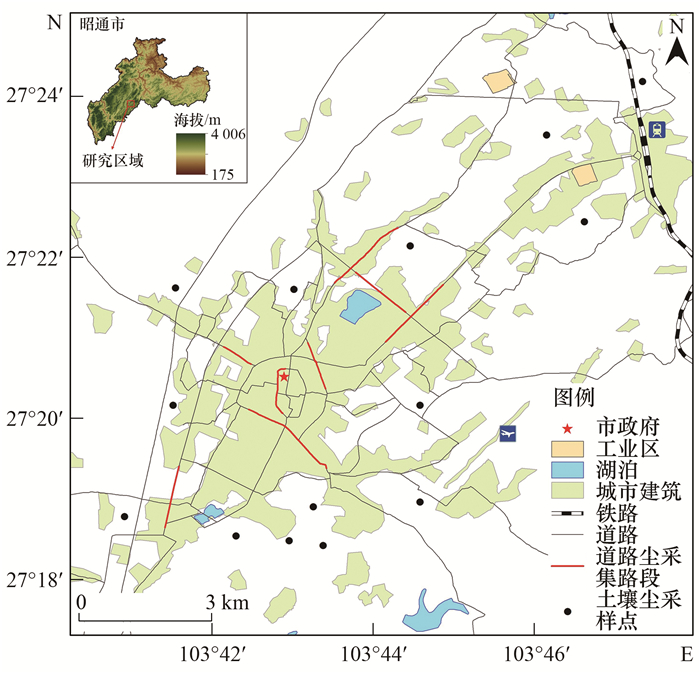
|
图 1 昭通市土壤尘采样点及道路尘采集路段示意 Fig. 1 Sampling sites for soil dust and road dust around the urban areas of Zhaotong City |
将采集的样品带回实验室去除砂石、枝叶等杂物, 在室温、通风和避光条件下自然晾干, 然后用150目的不锈钢筛进行筛分, 过筛的量不少于100 g.通过再悬浮采样器(NK-ZXF, 南开大学)将过筛的尘样采集于直径为47 mm的Teflon膜(MK360, 瑞典Munktell公司)上, 最终得到22个PM2.5样品.空白滤膜采样前置于60℃的烘箱中烘烤2 h以去除滤膜上的杂质, 采样前后将滤膜置于恒温恒湿(温度: 25℃±1℃; 湿度: 30%±5%)的环境中平衡24 h后再进行称重.
1.3 样品分析及质量保证将载有PM2.5样品的滤膜准确剪取1/2后剪碎放入锥形瓶中, 加适量去离子水润湿, 之后加入15 mL HNO3和5 mL HClO4, 在电热板上加热锥形瓶, 温度控制在100℃左右, 约1 h后将温度提升至160℃, 当酸剩余约3 mL时, 冷却锥形瓶, 加入适量去离子水, 过滤残渣并定容至25 mL容量瓶.采用电感耦合等离子体质谱仪(ICP-MS, 美国Agilent公司, Agilent 7500a型)对PM2.5中的V、Cr、Mn、Co、Ni、Cu、Zn、As、Cd和Pb等10种重金属进行定量分析.另一半滤膜按碱熔法[25]消解后采用电感耦合等离子体光谱仪(ICP-OES, 美国PerkinElmer公司, Optima 7000DV型)对PM2.5中的Ca、Al、Fe、Mg和Ti等地壳元素进行定量分析.
每10个样品执行一个重复样品、一个空白分析及一个空白加标回收分析.重复样品分析中目标元素含量的相对误差均小于10%, 且空白分析中目标元素的含量均低于二倍方法检出限[26].空白加标回收分析中, 每次称取10 mg的GBW07407土壤标准物质与剪碎的空白滤膜进行消解[25], 然后按照样品分析步骤进行ICP-MS和ICP-OES分析, 回收率均在90% ~110%内.样品分析数据最终均扣除了空白样品的均值.
1.4 富集因子法富集因子法(EF)是用来判断和评价环境中污染物来源的一种常用方法, 也是评价元素富集程度的重要指标[27].其公式如下:

|
(1) |
式中, EFi为土壤样品中测量元素i的富集因子; Ci和Cn分别为样品中测量i和参比元素n的含量; Bi和Bn分别为土壤背景值中测量元素i和参比元素n的含量.本研究使用Al作为参比元素, 重金属元素背景值参考云南省表层(A层)土壤背景值, 见表 3.若EF≤10, 主要受自然源影响; 若EF>10, 则主要受人为源影响, 且元素的EF值越大, 说明其污染程度越大, 人类活动对该元素造成的影响越大[28].
1.5 健康风险评价本研究采用美国环保署(EPA)提供的健康风险评价模型对扬尘中重金属进行评估, 其中Mn、Cu、Zn、Pb和V属于非致癌物质, Cr、Co、Ni、As和Cd属于致癌物质.本研究对象为儿童和成人两个群体, 人体通过摄食、呼吸吸入和皮肤接触这3种途径暴露于扬尘中的日均暴露量的计算公式如下:

|
(2) |

|
(3) |

|
(4) |
由于EPA只给出了呼吸途径的致癌风险参数, 因此本研究只考虑呼吸途径的致癌风险, 其终身日均暴露量(LADD)计算公式为:
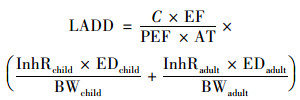
|
(5) |
式中, Ding、Dinh和Ddermal分别代表摄食、呼吸吸入和皮肤接触的日均暴露剂量, mg·(kg·d)-1; C表示重金属含量, mg·kg-1; 其余参数见表 1.
|
|
表 1 重金属暴露参数[14] Table 1 Exposure parameters of heavy metals |
重金属的非致癌总风险值(HI)和终身致癌总风险值(RT)计算公式如下:

|
(6) |

|
(7) |
式中, HQij为重金属i元素在j途径的非致癌风险值; Ri为重金属i元素的致癌风险值; RFDij为重金属i在j途径暴露的参考剂量, mg·(kg·d)-1; SF为致癌斜率因子, mg·(kg·d)-1, 具体参数见表 3.若HI < 1.00E+00, 则表示致癌风险较小或可以忽略; 若HI≥1.00E+00, 则表示存在非致癌风险, 且风险随着HI值的增大而增大; 当RT < 1.00E-06时, 认为存在较低的致癌风险; 当RT介于1.00E-06~1.00E-04时, 认为存在一定的致癌; 当RT≥1.00E-04时, 认为存在较高的致癌风险.
|
|
表 2 重金属参考剂量和致癌斜率因子/mg ·(kg ·d)-1 Table 2 Reference doses and slope factors of heavy metals/mg ·(kg ·d)-1 |
|
|
表 3 昭通周边扬尘中金属元素含量/mg ·kg-1 Table 3 Concentrations of metal elements in the two types of fugitive dust around Zhaotong City/mg ·kg-1 |
2 结果与讨论 2.1 元素含量水平特征
表 3给出了昭通市主城区扬尘中15种金属元素的含量, 土壤尘和道路尘的金属元素总平均含量分别为227.58 g·kg-1和206.74 g·kg-1, 两种扬尘中地壳元素占主要成分, 其含量之和分别占其PM2.5的质量分数为22.76%和20.67%.土壤尘中地壳元素的含量表现为: Al>Fe>Ca>Ti>Mg, 道路尘中地壳元素的含量表现为: Ca>Al>Fe>Ti>Mg, 道路尘Ca的含量高于土壤尘, 而其余地壳元素含量则表现为土壤尘大于道路尘.
土壤尘和道路尘中V、Cr、Mn、Co、Ni、Cu、Zn、As、Cd和Pb等10种重金属平均含量之和分别为: 2 516.46 mg·kg-1和2 408.64 mg·kg-1, 占其PM2.5的质量分数为0.25%和0.24%, 10种重金属在土壤尘中的含量大小顺序为: Mn>Cr>Ni>Zn>Cu>Co>Pb>V>As>Cd, 分别为土壤背景值的1.68、7.09、4.85、2.12、3.75、2.99、7.72、0.55、3.42和132.54倍; 道路尘中10种重金属的含量大小顺序为: Zn>Mn>Cu>Cr>Pb>Ni>As>Co>V>Cd, 为土壤背景值的8.29、0.74、4.37、6.11、8.49、3.33、3.35、3.40、0.36和98.20倍.两种扬尘中, 仅V的含量未超过云南土壤背景值.昭通扬尘中, V、Cr、Mn、Co、Ni、As和Cd的含量总体上表现为土壤尘大于道路尘, 且如图 2所示, 两种扬尘的Cr、Ni和As的含量均高于其它城市, 处于较高水平.昭通土壤尘中重金属元素的总含量仅次于香港, Mn的含量在10种重金属中最高, Cr、Co、Ni和As的含量高于其它城市, 除地处高土壤母质背景区外, 可能受其它人为活动影响.在昭通道路尘中, Cu、Zn和Pb的含量高于土壤尘, 其含量是土壤尘的1.86、3.90和2.05倍, Zn的含量在10种重金属中最高, 且Zn、Pb和Cu的含量之和占重金属总含量的50%以上, 这与苏州、香港和Big Bend的道路尘类似.
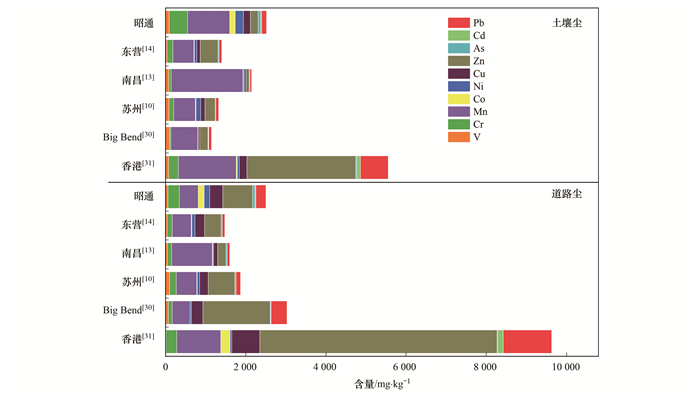
|
图 2 不同城市扬尘中重金属含量比较 Fig. 2 Comparison of the contents of heavy metals in the two types of fugitive dust among different cities |
图 3给出了昭通扬尘金属元素的EF.Ca、Al、Fe、Mg和Ti等地壳元素中, 土壤尘和道路尘中Mg、Ti和Al的EF小于10, 而Ca和Fe的EF在10~100之间, 表现为中度富集, 表明两种扬尘的Ca和Fe受一定的人为活动影响.在土壤尘中, Cr、Mn、Co、Ni、Cu、Zn、As和Pb的EF小于10, 表现为轻度富集, 主要受自然源影响.在道路尘中, V、Cr、Mn、Co、Ni和As的EF小于10, 而Cu、Zn和Pb的EF在10~100之间, 为中度富集, 表明Cu、Zn和Pb主要受人为源影响.Cd在两种扬尘中的EF均大于100, 表现为高度富集, 受强烈的人为污染影响.Cd主要来源于燃煤活动[1, 32, 33], 昭通无钢铁冶炼行业, 褐煤化工、矿冶加工是昭通的七大支柱产业之一, 且昭通市2019年居民能源消耗量为106.92万吨标准煤, 占总能源消耗用煤的13.85%[34], 两种扬尘的Mn/V值也均远大于1, 表明两种扬尘均受燃煤活动影响[10, 35].
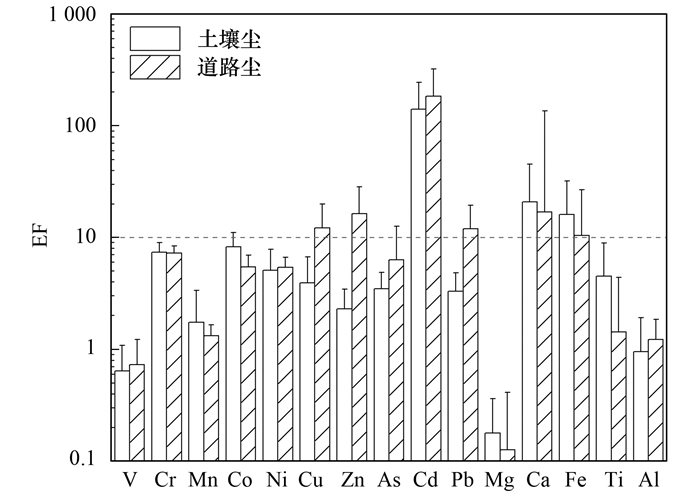
|
图 3 扬尘中金属元素的富集因子 Fig. 3 Enrichment factors of metal elements in the two types of fugitive dust |
元素间的相关性可以反映其是否具有同源性, 图 4为两种扬尘中元素之间的Pearson相关性系数.土壤尘中, Cr、Mn、Co、Ni、Cu、Zn和Cd之间均呈显著正相关(r≥0.50, P≤0.05), 表明这些重金属之间具有较强的关联性.Cr、Mn、Co、Ni、Cu和As与地壳元素(Mg、Fe、Ti和Al)[7, 11]之间呈显著正相关(r≥0.50, P≤0.05), 表明Cr、Mn、Co、Ni、Cu和As与地壳元素具有同源性, 而Zn和Cd与地壳元素之间无显著相关性, 表明土壤尘中Zn和Cd存在一定程度的人为污染.Ca仅和Mg呈显著相关(r=0.63, P≤0.05), 而Ca和Mg是建筑尘的标志组分[36], 表明Ca和Mg可能受建筑尘影响.V和Pb与其它元素无显著相关性, 表明其可能存在其它源.
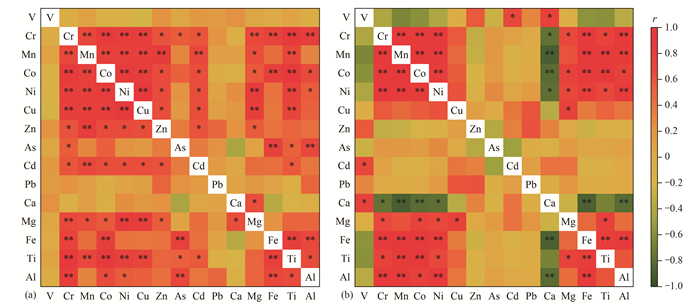
|
(a)土壤尘, (b)道路尘; *表示P≤ 0.05, **表示P≤ 0.01 图 4 土壤尘与道路尘中金属元素之间的相关系数 Fig. 4 Correlation coefficients among metal elements in soil fugitive dust and road fugitive dust |
道路尘中, Cu、Zn、As、Cd和Pb与其它元素之间无显著相关性, 而Cr、Mn、Co和Ni与地壳元素(Mg、Fe、Ti和Al)之间呈显著正相关(r≥0.60, P≤0.05), 表明Cr、Mn、Co和Ni与地壳元素具有同源性.Ca与Cr、Mn、Co、Ni、Fe和Al呈显著负相关(r≤-0.60, P≤0.05), 而V与Ca和Cd呈显著正相关(r≥0.50, P≤0.05).同时, 昭通主城区道路建设材料富含Ca[4].因此, 推断道路尘中Ca、V和Cd等元素可能来源于路面磨损和机动车尾气排放[37~39].
2.4 主成分分析为进一步判断土壤尘与道路尘中重金属的来源异同, 对重金属含量数据进行检验(KMO>0.50, Bartlett < 0.05), 最终将土壤尘与道路尘中载带的Cr、Co、Ni、Cu、Zn和Pb通过SPSS 25.0进行主成分分析, 截取了特征值大于1的因子以讨论两种扬尘中重金属的来源, 正交旋转后的成分矩阵见表 4.土壤尘(KMO=0.56, Bartlett=0.00)与道路尘(KMO=0.67, Bartlett=0.01)分别解析获得了2个因子.
|
|
表 4 土壤尘和道路尘中重金属主成分分析 Table 4 Principal component analysis of heavy metals in soil fugitive dust and road fugitive dust |
土壤尘的因子1解释方差为66.00%, 负载较高的系数有Cr、Co、Ni和Cu, 且Cr、Co、Ni和Cu的EF值均低于10, 受人为源影响较小.而昭通土壤中Cr、Co、Ni和Cu等重金属具有典型的母岩继承性[22, 40], 表明因子1符合本地土壤母质重金属的特征.此外, 土壤尘多受到施肥、污水灌溉和农药喷洒等农业活动的影响, 可能在土壤中富集Cu和Zn等重金属[12, 41, 42].可以推断, 因子1为土壤母质源和农业活动源; 因子2解释方差为23.06%, 负载系数以Pb为主, 而Pb一般与燃煤相关活动有关[28, 43].因此, 因子2可作为燃煤源.
道路尘的因子1解释方差为54.96%, 负载系数较高的重金属有Cr、Co和Ni(EF值均小于10), 且有研究表明道路尘中Cr、Co和Ni主要受土壤母质影响[26, 38, 44].因此, 可以推断, 因子1代表土壤母质源; 因子2解释方差为31.16%, 负载系数以Pb、Zn和Cu为主(EF值均大于10).有研究表明, Pb主要来源于燃煤活动[45], 而Zn和Cu主要与机动车抗氧化剂、润滑油使用、刹车片磨损和轮胎摩擦等排放有关[46].因此, 因子2可看作为交通与燃煤混合源.
综上, 两种扬尘中重金属均受燃煤源的影响, 但土壤尘和道路尘中重金属还分别受到农业活动源和交通源的影响而存在一定的来源差异.
2.5 健康风险研究 2.5.1 非致癌风险图 5为儿童与成人在摄食、呼吸吸入和皮肤接触暴露途径下的非致癌暴露风险值(HQ).在两种扬尘中, 儿童3种暴露途径的非致癌风险强度顺序为: 摄食>皮肤接触>呼吸吸入, HQing占非致癌总风险值(HI)的89.88%, 表明摄食途径是扬尘中造成儿童重金属非致癌风险的主要途径; 而成人的3种暴露途径的非致癌风险强度顺序为: 皮肤接触>摄食>呼吸吸入, HQdermal占HI的40.68%, 表明皮肤接触途径是扬尘中造成成人重金属非致癌风险的主要途径.
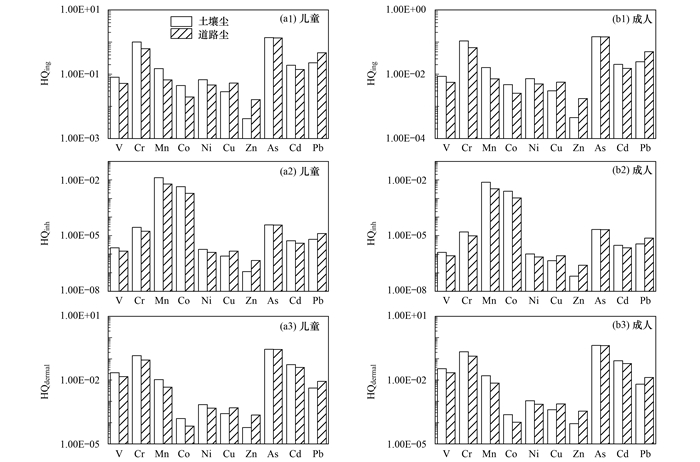
|
HQing、HQinh和HQdermal分别为摄食、呼吸吸入和皮肤接触的非致癌暴露风险值 图 5 扬尘中重金属非致癌暴露风险值 Fig. 5 Risk value of non-carcinogenic exposure of heavy metals in the two types of fugitive dust |
两种扬尘10种重金属的各暴露途径的HQ均表现为儿童大于成人, 土壤尘与道路尘中10种重金属的儿童HI分别为: 3.72E+00和3.28E+00, 成人的HI为1.14E+00和0.97E+00, 两种扬尘的儿童HI均大于1.00E+00, 存在非致癌风险, 且是成人HI的3.26和3.38倍.道路尘中Pb、Cu和Zn的HI高于土壤尘, 其余重金属的HI小于土壤尘, 这与含量水平特征一致.无论成人还是儿童, 两种扬尘As的HI高于其它重金属, 其次为Cr, 而Zn的HI最低.在土壤尘和道路尘中, 儿童As的HI分别为1.66E+00和1.63E+00, 土壤尘的Cr在儿童中的HI为1.15E+00, 存在一定的非致癌风险, 应加强对儿童的扬尘风险防护.
2.5.2 致癌风险表 5为昭通两种扬尘中Cr、Co、Ni、As和Cd的终身致癌暴露剂量(LADD)与终身致癌风险值(R). 5种重金属的LADD与R表现为土壤尘高于道路尘.土壤尘中重金属的致癌风险强度表现为: Cr>Co>As>Cd>Ni, 而道路尘: Cr>As>Co>Cd>Ni.土壤尘的终身致癌总风险值(RT)大于1.00E-06, 存在一定的致癌风险, 土壤尘和道路尘中Cr的终身致癌总风险值在RT中占比最高, 分别占RT的88.07%和87.13%.
|
|
表 5 扬尘中重金属的终身致癌暴露剂量与终身致癌风险值 Table 5 Lifetime exposure doses and lifetime carcinogenic risk values of heavy metals in the two types of fugitive dust |
3 结论
(1) 土壤尘和道路尘中10种重金属的平均含量分别为2 516.46 mg·kg-1和2 408.64 mg·kg-1, 土壤尘中重金属的含量大小顺序为: Mn>Cr>Ni>Zn>Cu>Co>Pb>V>As>Cd; 道路尘中重金属的含量大小顺序为: Zn>Mn>Cu>Cr>Pb>Ni>As>Co>V>Cd, 两种扬尘中仅V未超过云南土壤重金属背景值.
(2) 富集因子表明, Cd在两种扬尘中均表现为强烈富集, Cu、Zn和Pb在道路尘中表现为中度富集, 其余重金属均表现为轻度富集.结合相关性和主成分分析可知, 道路尘中重金属受燃煤源和交通源影响, 而土壤尘中重金属受燃煤源和农业源影响.
(3) 健康风险分析表明, 土壤尘中Cr和As均存在儿童非致癌风险, 而道路尘中仅有As存在儿童非致癌风险.Cr、Co、Ni、As和Cd均不存在终身致癌风险.因此, 应对此研究区域扬尘中的Cr和As加强关注.
| [1] | Liu J W, Chen Y J, Chao S H, et al. Emission control priority of PM2.5-bound heavy metals in different seasons: a comprehensive analysis from health risk perspective[J]. Science of the Total Environment, 2018, 644: 20-30. DOI:10.1016/j.scitotenv.2018.06.226 |
| [2] |
吴明, 吴丹, 夏俊荣, 等. 成都冬季PM2.5化学组分污染特征及来源解析[J]. 环境科学, 2019, 40(1): 76-85. Wu M, Wu D, Xia J R, et al. Analysis of pollution characteristics and sources of PM2.5 chemical components in Chengdu in winter[J]. Environmental Science, 2019, 40(1): 76-85. DOI:10.3969/j.issn.1673-2049.2019.01.009 |
| [3] |
张剑飞, 姜楠, 段时光, 等. 郑州市PM2.5化学组分的季节变化特征及来源解析[J]. 环境科学, 2020, 41(11): 4813-4824. Zhang J F, Jiang N, Duan S G, et al. Seasonal chemical composition characteristics and source apportionment of PM2.5 in Zhengzhou[J]. Environmental Science, 2020, 41(11): 4813-4824. DOI:10.3969/j.issn.1000-6923.2020.11.021 |
| [4] | Cesari D, Contini D, Genga A, et al. Analysis of raw soils and their re-suspended PM10 fractions: characterisation of source profiles and enrichment factors[J]. Applied Geochemistry, 2012, 27(6): 1238-1246. DOI:10.1016/j.apgeochem.2012.02.029 |
| [5] | Wei B G, Yang L S. A review of heavy metal contaminations in urban soils, urban road dusts and agricultural soils from China[J]. Microchemical Journal, 2010, 94(2): 99-107. DOI:10.1016/j.microc.2009.09.014 |
| [6] | Ho K F, Wu K C, Niu X Y, et al. Contributions of local pollution emissions to particle bioreactivity in downwind cities in China during Asian dust periods[J]. Environmental Pollution, 2019, 245: 675-683. DOI:10.1016/j.envpol.2018.11.035 |
| [7] | Pan Y P, Tian S L, Li X R, et al. Trace elements in particulate matter from metropolitan regions of Northern China: Sources, concentrations and size distributions[J]. Science of the Total Environment, 2015, 537: 9-22. DOI:10.1016/j.scitotenv.2015.07.060 |
| [8] | Han Q, Wang M S, Cao J L, et al. Health risk assessment and bioaccessibilities of heavy metals for children in soil and dust from urban parks and schools of Jiaozuo, China[J]. Ecotoxicology and Environmental Safety, 2020, 191. DOI:10.1016/j.ecoenv.2019.110157 |
| [9] | Chow J C, Watson J G, Houck J E, et al. A laboratory resuspension chamber to measure fugitive dust size distributions and chemical compositions[J]. Atmospheric Environment, 1994, 28(21): 3463-3481. DOI:10.1016/1352-2310(94)90005-1 |
| [10] | Wu F Q, Kong S F, Yan Q, et al. Sub-type source profiles of fine particles for fugitive dust and accumulative health risks of heavy metals: a case study in a fast-developing city of China[J]. Environmental Science and Pollution Research, 2020, 27(14): 16554-16573. DOI:10.1007/s11356-020-08136-1 |
| [11] | Zhang R, Cao J J, Tang Y R, et al. Elemental profiles and signatures of fugitive dusts from Chinese deserts[J]. Science of the Total Environment, 2014, 472: 1121-1129. DOI:10.1016/j.scitotenv.2013.11.011 |
| [12] | Cao J J, Chow J C, Watson J G, et al. Size-differentiated source profiles for fugitive dust in the Chinese Loess Plateau[J]. Atmospheric Environment, 2008, 42(10): 2261-2275. DOI:10.1016/j.atmosenv.2007.12.041 |
| [13] |
郑权. 南昌市开放源PM2.5中化学组分特征及有害组分风险评价[D]. 泉州: 华侨大学, 2019. Zheng Q. Characteristics of chemical components and risk assessment of harmful components in PM2.5 of fugitive dust in Nanchang City[D]. Quanzhou: Huaqiao University, 2019. |
| [14] |
孔少飞. 大气污染源排放颗粒物组成、有害组分风险评价及清单构建研究[D]. 天津: 南开大学, 2012. Kong S F. Study on the chemical composition, risk assessment and emission inventory establishment for hazardous components in particulate matter from atmospheric pollution sources[D]. Tianjin: Nankai University, 2012. |
| [15] | Liu Y Y, Zhang W J, Bai Z P, et al. Characteristics of PM10 chemical source profiles for geological dust from the South-West region of China[J]. Atmosphere, 2016, 7(11). DOI:10.3390/atmos7110146 |
| [16] |
樊馨瑶, 卢新卫, 刘慧敏, 等. 西安市高校校园地表灰尘重金属污染来源解析[J]. 环境科学, 2020, 41(8): 3556-3562. Fan X Y, Lu X W, Liu H M, et al. Pollution and source analysis of heavy metal in surface dust from Xi'an University campuses[J]. Environmental Science, 2020, 41(8): 3556-3562. |
| [17] | Zhu C Y, Maharajan K, Liu K C, et al. Role of atmospheric particulate matter exposure in COVID-19 and other health risks in Human: a review[J]. Environmental Research, 2021, 198. DOI:10.1016/j.envres.2021.111281 |
| [18] | Bai K J, Ho S C, Tsai C Y, et al. Exposure to PM2.5 is associated with malignant pleural effusion in lung cancer patients[J]. Ecotoxicology and Environmental Safety, 2021, 208. DOI:10.1016/j.ecoenv.2020.111618 |
| [19] |
董世豪, 谢扬, 皇甫延琦, 等. 扬州市PM2.5中重金属来源及潜在健康风险评估[J]. 环境科学, 2019, 40(2): 540-547. Dong S H, Xie Y, Huangfu Y Q, et al. Source apportionment and heath risk quantification of heavy metals in PM2.5 in Yangzhou, China[J]. Environmental Science, 2019, 40(2): 540-547. |
| [20] | Peng X, Shi G L, Liu G R, et al. Source apportionment and heavy metal health risk (HMHR) quantification from sources in a southern city in China, using an ME2-HMHR model[J]. Environmental Pollution, 2017, 221: 335-342. DOI:10.1016/j.envpol.2016.11.083 |
| [21] |
李雅. 基于土壤发生分类的云南省土壤重金属空间分异及污染评估[D]. 昆明: 云南大学, 2019. Li Y. Spatial distribution and pollution assessment of soil heavy metals in Yunnan Province based on soil genetic classification[D]. Kunming: Yunnan University, 2019. |
| [22] |
成晓梦. 云南不同成土母质土壤剖面中重金属元素地球化学行为与风险分析[D]. 北京: 中国地质大学(北京), 2016. Cheng X M. Geochemical behavior and risk analysis for heavy elements in soil profiles with different parent material, Yunnan Province, China[D]. Beijing: China University of Geosciences (Beijing), 2016. |
| [23] |
岳敏慧, 王朋, 禹明慧, 等. 云南地区土壤重金属污染危害及其防治措施建议[J]. 农业科学, 2019, 9(4): 278-289. Yue M H, Wang M, Yu M H, et al. The harm of soil heavy metal pollution in Yunnan Province and its prevention and control measures[J]. Hans Journal of Agricultural Sciences, 2019, 9(4): 278-289. DOI:10.3969/j.issn.0517-6611.2019.04.075 |
| [24] | 李建波. 昭通市特色产业发展研究[D]. 昆明: 云南财经大学, 2010. |
| [25] |
HJ 777-2015, 空气和废气颗粒物中金属元素的测定电感耦合等离子体发射光谱法[S]. HJ 777-2015, Ambient air and waste gas from stationary sources emission-determination of metal elements in ambient particle matter-inductively coupled plasma optical emission spectrometry[S]. |
| [26] |
冯于耀, 史建武, 钟曜谦, 等. 有色冶炼园区道路扬尘中重金属污染特征及健康风险评价[J]. 环境科学, 2020, 41(8): 3547-3555. Feng Y Y, Shi J W, Zhong Y Q, et al. Pollution characteristics and health risk assessment of heavy metals in road dust from non-ferrous smelting parks[J]. Environmental Science, 2020, 41(8): 3547-3555. |
| [27] | Wang H B, Qiao B Q, Zhang L M, et al. Characteristics and sources of trace elements in PM2.5 in two megacities in Sichuan Basin of Southwest China[J]. Environmental Pollution, 2018, 242: 1577-1586. DOI:10.1016/j.envpol.2018.07.125 |
| [28] | Zhou S Z, Yuan Q, Li W J, et al. Trace metals in atmospheric fine particles in one industrial urban city: spatial variations, sources, and health implications[J]. Journal of Environmental Sciences, 2014, 26(1): 205-213. DOI:10.1016/S1001-0742(13)60399-X |
| [29] | 国家环境保护局. 中国土壤元素背景值[M]. 北京: 中国环境科学出版社, 1990. |
| [30] | Chow J C, Watson J G, Kuhns H, et al. Source profiles for industrial, mobile, and area sources in the Big Bend Regional Aerosol Visibility and Observational study[J]. Chemosphere, 2004, 54(2): 185-208. DOI:10.1016/j.chemosphere.2003.07.004 |
| [31] | Ho K F, Lee S C, Chow J C, et al. Characterization of PM10 and PM2.5 source profiles for fugitive dust in Hong Kong[J]. Atmospheric Environment, 2003, 37(8): 1023-1032. DOI:10.1016/S1352-2310(02)01028-2 |
| [32] | Taiwo A M, Harrison R M, Shi Z B. A review of receptor modelling of industrially emitted particulate matter[J]. Atmospheric Environment, 2014, 97: 109-120. DOI:10.1016/j.atmosenv.2014.07.051 |
| [33] | Shen F, Liao R M, Ali A, et al. Spatial distribution and risk assessment of heavy metals in soil near a Pb/Zn smelter in Feng County, China[J]. Ecotoxicology and Environmental Safety, 2017, 139: 254-262. DOI:10.1016/j.ecoenv.2017.01.044 |
| [34] | 云南省统计局. 2020年云南统计年鉴[M]. 北京: 中国统计出版社, 2020. |
| [35] | Sun J, Shen Z X, Zhang L M, et al. Chemical source profiles of urban fugitive dust PM2.5 samples from 21 cities across China[J]. Science of the Total Environment, 2019, 649: 1045-1053. DOI:10.1016/j.scitotenv.2018.08.374 |
| [36] |
张伟, 姬亚芹, 张军, 等. 辽宁省典型城市道路尘PM2.5成分谱研究[J]. 中国环境科学, 2018, 38(2): 412-417. Zhang W, Ji Y Q, Zhang J, et al. Study on the road dust source profile of PM2.5 in Liaoning Province typical cities[J]. China Environmental Science, 2018, 38(2): 412-417. DOI:10.3969/j.issn.1000-6923.2018.02.002 |
| [37] | Wang Y F, Huang K L, Li C T, et al. Emissions of fuel metals content from a diesel vehicle engine[J]. Atmospheric Environment, 2003, 37(33): 4637-4643. DOI:10.1016/j.atmosenv.2003.07.007 |
| [38] | Fiala M, Hwang H M. Influence of highway pavement on metals in road dust: a case study in Houston, Texas[J]. Water, Air, & Soil Pollution, 2021, 232(5). DOI:10.1007/s11270-021-05139-7 |
| [39] | Han N M M, Latif M T, Othman M, et al. Composition of selected heavy metals in road dust from Kuala Lumpur city centre[J]. Environmental Earth Sciences, 2014, 72(3): 849-859. DOI:10.1007/s12665-013-3008-5 |
| [40] |
彭敏. 西南典型地质高背景区土壤-作物系统重金属迁移富集特征与控制因素[D]. 北京: 中国地质大学(北京), 2020. Peng M. Heavy metals in soil-crop system from typical high geological background areas, Southwest China: transfer characteristics and controlling factors[D]. Beijing: China University of Geosciences (Beijing), 2020. |
| [41] |
王飞, 赵立欣, 沈玉君, 等. 华北地区畜禽粪便有机肥中重金属含量及溯源分析[J]. 农业工程学报, 2013, 29(19): 202-208. Wang F, Zhao L X, Shen Y J, et al. Analysis of heavy metal contents and source tracing in organic fertilizer from livestock manure in North China[J]. Transactions of the Chinese Society of Agricultural Engineering, 2013, 29(19): 202-208. DOI:10.3969/j.issn.1002-6819.2013.19.025 |
| [42] | Wang Y T, Guo G H, Zhang D G, et al. An integrated method for source apportionment of heavy metal(loid)s in agricultural soils and model uncertainty analysis[J]. Environmental Pollution, 2021, 276. DOI:10.1016/j.envpol.2021.116666 |
| [43] | Zhang K, Chai F H, Zheng Z L, et al. Size distribution and source of heavy metals in particulate matter on the lead and zinc smelting affected area[J]. Journal of Environmental Sciences, 2018, 71: 188-196. DOI:10.1016/j.jes.2018.04.018 |
| [44] | Soltani N, Keshavarzi B, Moore F, et al. Ecological and human health hazards of heavy metals and polycyclic aromatic hydrocarbons (PAHs) in road dust of Isfahan metropolis, Iran[J]. Science of the Total Environment, 2015, 505: 712-723. DOI:10.1016/j.scitotenv.2014.09.097 |
| [45] |
邓林俐, 张凯山, 殷子渊, 等. 基于PMF模型的PM2.5中金属元素污染及来源的区域特征分析[J]. 环境科学, 2020, 41(12): 5276-5287. Deng L L, Zhang K S, Yin Z Y, et al. Characterization of metal pollution of regional atmospheric PM2.5 and its sources based on the PMF model[J]. Environmental Science, 2020, 41(12): 5276-5287. |
| [46] | Lin Y C, Li Y C, Amesho K T T, et al. Chemical characterization of PM2.5 emissions and atmospheric metallic element concentrations in PM2.5 emitted from mobile source gasoline-fueled vehicles[J]. Science of the Total Environment, 2020, 739. DOI:10.1016/j.scitotenv.2020.139942 |
 2022, Vol. 43
2022, Vol. 43


